Integrating phosphorus management and cropping technology for sustainable maize production
Haiqing Gong ,Yue Xiang ,Jiechen Wu ,Laichao Luo ,Xiaohui Chen ,Xiaoqiang Jiao# ,Chen Chen,4#
1 State Key Laboratory of Nutrient Use and Management,College of Resources and Environmental Sciences,College of Resources and Environmental Sciences,China Agricultural University,Beijing 100193,China
2 Department of Sustainable Development,Environmental Science and Engineering (SEED),KTH Royal Institute of Technology,Stockholm SE-100 44,Sweden
3 Anhui Province Key Lab of Farmland Ecological Conservation and Pollution Prevention,School of Resources and Environment,Anhui Agricultural University,Hefei 230036,China
4 Ministry of Education Key Laboratory for Biodiversity Science and Ecological Engineering,National Observations and Research Station for Wetland Ecosystems of the Yangtze Estuary,Institute of Biodiversity Science and Institute of Eco-Chongming,College of Life Sciences,Fudan University,Shanghai 200438,China
Abstract Achieving high maize yields and efficient phosphorus (P) use with limited environmental impacts is one of the greatest challenges in sustainable maize production.Increasing plant density is considered an effective approach for achieving high maize yields.However,the low mobility of P in soils and the scarcity of natural P resources have hindered the development of methods that can simultaneously optimize P use and mitigate the P-related environmental footprint at high plant densities.In this study,meta-analysis and substance flow analysis were conducted to evaluate the effects of different types of mineral P fertilizer on maize yield at varying plant densities and assess the flow of P from rock phosphate mining to P fertilizer use for maize production in China.A significantly higher yield was obtained at higher plant densities than at lower plant densities.The application of single superphosphate,triple super-phosphate,and calcium magnesium phosphate at high plant densities resulted in higher yields and a smaller environmental footprint than the application of diammonium phosphate and monoammonium phosphate.Our scenario analyses suggest that combining the optimal P type and application rate with a high plant density could increase maize yield by 22%.Further,the P resource use efficiency throughout the P supply chain increased by 39%,whereas the P-related environmental footprint decreased by 33%.Thus,simultaneously optimizing the P type and application rate at high plant densities achieved multiple objectives during maize production,indicating that combining P management with cropping techniques is a practical approach to sustainablemaize production.These findings offer strategic,synergistic options for achieving sustainable agricultural development.
Keywords: maize,plant density,mineral phosphorus fertilizer,meta-analysis,substance flow analysis
1.Introduction
Increasing maize (Zea maysL.) yield while improving the efficient use of phosphorus (P) is one of the greatest challenges in sustainable agricultural development (Langhanset al.2022).P is a critical element for maize production (Erelet al.2017),and appropriate inputs of mineral P fertilizer are required to achieve sufficient maize production (Conijnet al.2018).However,the excessive application of such fertilizers has resulted in the accumulation of P in soils owing to its low solubility (Sattariet al.2014),which has led to serious environmental problems,such as air and water pollution as well as contributing to climate change (Alewellet al.2020;Fanet al.2021).Therefore,mineral P management must be optimized to improve maize yield and P use efficiency.
More than 30% of potential maize yield is lost because of inadequate plant densities (Miet al.2016).Increasing the plant density is an effective cropping technique for increasing the potential maize yield per hectare (Zhanget al.2021).The main goal of increasing plant density is to increase the efficiency and competitiveness of the maize system per unit area by enhancing maize yield in terms of grain production or biomass (Testaet al.2016;Zhanget al.2022).However,the growth space available for maize roots per plant decreases with increasing plant density,resulting in smaller roots (Gonget al.2021).Additionally,the total length of the roots decreases because of the soil volume occupied by the root system (Wanget al.2020).Depending on root morphology,these changes may increase the difficulty of acquiring P from the soil (Lamberset al.2015).P mobility in soil is limited (Witherset al.2014),and with increasing plant density,acquiring P becomes more difficult because of decreased contact between roots and soil (Shaoet al.2018).Accordingly,identifying a strategy for improving the biological potential of roots to promote the efficient uptake of P from the soil while also increasing the plant density to achieve sustainable P use and high maize yields is crucial.
Several P management and cropping techniques have been established to control agricultural inputs and outputs and improve the P use efficiency in agricultural systems (Wuet al.2015;Qianet al.2016).For example,the National Soil Testing for Formulated Fertilization Project has been implemented in China since 2005 to maintain and control P accumulation in the soil (Liet al.2011).Additionally,root and rhizosphere management techniques have been developed to fully utilize legacy soil P and reduce dependence on mineral P fertilizer inputs (Shenet al.2013).Although these techniques offer valuable approaches for increasing the efficiency of P use in agricultural systems,most have only been evaluated individually,resulting in limited improvements in efficiency (Liet al.2015;Zhouet al.2021).Increasing the efficiency of nutrient use requires the integration of all major factors in an agricultural system,including the biophysical conditions of agronomic management practices (Wanget al.2021).Cropping techniques aimed at increasing plant density are frequently used to increase P acquisition and uptake by plants,thereby increasing crop yield (Liet al.2021).Therefore,rather than using a single P management strategy or individual cropping technique,multiple strategies and techniques should be integrated to support sustainable P use in agricultural systems.
To achieve sustainable P use,key aspects of P supply and use must be considered,including rock phosphate (RP) mining,P fertilizer manufacturing,and P use in crop production (Gonget al.2022).Achieving sustainable P use requires holistic and systematic approaches to managing crop production that focus on productivity and P resource use and the P-related environmental footprint in the supply chain (Cordell and White 2013).Understanding the flow of P and evaluating its loss throughout the supply chain will help guide decisionmaking for sustainable P management (Chowdhuryet al.2018).Systematic meta-analysis can be employed to resolve uncertainties and discrepancies that emerge from individual studies and have been used to compile and compare results from various investigations on mineral P fertilizers (Nagendrababuet al.2020;Gonget al.2022).Substance flow analysis (SFA) emphasizes the quantification of P flows,which can provide insights into prevention of P loss and improvement of P resource use efficiency (Wuet al.2016).Meta-analysis and SFA are widely used to integrate multiple studies on agricultural systems,identify general trends,and quantify flow and environmental footprint.The combination of P management and cropping techniques may lead to the development of a sustainable approach to P fertilization for maize production.However,methods of achieving an optimal combination of high maize yield,efficient use of P resources,and reduction in the P-related environmental footprintviathe integration of P management and cropping techniques have not been developed.
The integration of P management and cropping techniques would lead to a refined focus on the tradeoffs between crop yield and the environmental impact of sustainable P use.Such trade-offs include those related to productivity,P resources,and P-related environmental footprint.Understanding these trade-offs is essential for developing systematic strategies to increase maize yield,improve P resource use efficiency,and minimize the P-related footprint of maize production.In this study,we conducted a holistic meta-analysis that integrates previously published results on the responses of maize yield to mineral P fertilizers at different plant densities in China.By combining the meta-analysis with SFA,we estimated the P flow and P-related environmental footprint throughout the P supply chain,which extends from RP mining to P use in maize production.Our objectives were to: (1) quantify the increase in maize yield and the P-related environmental footprint induced by different P fertilizer applications at different planting densities and (2) explore an effective strategy for achieving high maize yields and P resource use efficiency while considerably mitigating the P-related environmental footprint.
2.Materials and methods
2.1.Meta-analysis of the effect of mineral P fertilizer on maize yield at different plant densities
Data collectionTo quantify the effect of mineral P fertilizer on maize yields at different plant densities,we searched the Web of Science and China National Knowledge Infrastructure (http://www.cnki.net/) for peerreviewed publications published between 1980 and 2021.A comprehensive literature review was performed using the search terms “phosphorus (P) OR phosphate OR phosphorus fertilizer AND yield AND maize (Zea maysL.)”.The published experiments were further screened for integrity,relevance,and scientific merit based on the following inclusion criteria: the studies must have: (1) been field-based studies conducted in China;(2) investigated the use of mineral P fertilizer and included control groups (i.e.,without P fertilizer application);(3) investigated management options,such as choice of mineral P fertilizer type and maize planting density;(4) reported final maize yields.To avoid cumulative or residual effects of mineral P fertilizers,we only included in our database data obtained during the first two years of any long-term experiments.
Based on the search criteria,we winnowed the results to 127 scientific journal articles,which included 242 sites with 477 pairwise comparisons,for inclusion in our metaanalysis.The experimental sites of the selected studies were distributed throughout the key maize-producing regions of China.All observations were included in the database.Information on mineral P fertilizer type (super-phosphate (SSP),triple super-phosphate (TSP),calcium magnesium phosphate (CMP),monoammonium phosphate (MAP),diammonium phosphate (DAP)),soil characteristics (soil pH and soil available P (SAP)),and plant density (low plant density,≤60,000 plants ha-1;high plant density,>60,000 plants ha-1) of the selected sites were included in our database.Furthermore,we collected and recorded other relevant data presented in the selected literature,such as the site location (longitude and latitude) and climate (mean annual temperature,(MAT),and mean annual precipitation (MAP).Data were obtained directly from tables or text in the respective articles or extracted from figures using GetData graph digitizer.
Data analysisThe efficiency of a given mineral P fertilizer under increases in maize yield at different plant densities was quantified as the natural log of the response ratio (lnRR) (Hedgeset al.1999) using the following equation:
whereXtrepresents the maize yield with mineral P fertilizer application,andXcrepresents the maize yield without mineral P application.As more than 50% of the case studies did not provide a standard error or deviation,bootstrap resampling (5,000 iterations) was performed to obtain the mean response ratio (RR,the effect size),with a bias-corrected confidence interval (CI) of 95% (Adamset al.1997).
The resampling estimates were more conservative because the obtained CIs were greater than the standard confidence limits (Adamset al.1997).The effect of P fertilizer application on yield was reported as the percentage change ((RR-1)×100),where negative values indicated a decrease in yield and positive values indicated an increase.The mean percentage change was considered significantly different from zero if the 95% CI did not overlap with zero (Hedgeset al.1999).
The effects of climatic conditions (MAT and MAP),soil characteristics (pH and SAP),and management practices (total P input) on the responses of maize yield to mineral P fertilizer were predicted using a random forest model and the package “randomforest” in R (version 4.2.0;R Development Core Team).A structural equation model was constructed to evaluate the direct and indirect effects and significance of these variables on the lnRR.A prior model was established based on the known relationships among these drivers and lnRR.The Chi-square (X2) statistic,whole-modelP-value,goodness-of-fit index (GFI),and root mean square error of approximation (RMSEA<0.08) were used to assess the overall goodness of fit of the model (Schermelleh-Engelet al.2003).The computations were performed using the “lavaan” package in R (ver.4.2.0;R Development Core Team).SPSS (v.20.0;SPSS Inc.,USA) was used to analyze the correlations among the variables using Spearman’s correlation analysis.We calculated the standardized total effects of each factor on the lnRR by summing all the direct and indirect pathways between each factor and the lnRR.
2.2.Substance flow analysis of P from RP mining to maize production
System boundariesWe used a mass balance-based partial SFA to quantify the P flows from RP mining to P use in maize production (Appendix A).In this study,“P inflow” included the amount of P from RP,irrigation,and deposition,and “P outflow” included the amount of P uptake by maize production and loss through soil erosion,runoff,and leaching.The amount of P uptake by maize production was defined as “productive outflow”;the amount of P outflow by soil erosion,runoff,and leaching was defined as “unproductive outflow”;and the amount of P storedviasoil accumulation was defined as “P storage” (Gonget al.2022).
Data collection and processingWe identified 26 balance equations to estimate the P flow from RP mining to P use in maize production (Appendix B).The coefficients for calculating P flow from fertilizer manufacturing were obtained from surveys conducted by the secondlargest global mineral P fertilizer manufacturer in southwestern China (Gonget al.2022).The remaining coefficients were obtained from peer-reviewed studies (Appendix C).The P flow analysis of P from RP mining to use in maize production were plotted using e!Sankey (v.4.1;ifu Hamburg GmbH,Germany).
P resource use efficiency (%) throughout the supply chain was calculated as the ratio of the total P uptake by maize to the amount of P in RP that is required by the P supply chain as follows:
where Puptake(kg P ha-1) is the amount of P consumed by maize crops and Prock(kg P ha-1) is the total amount of P in RP applied to the maize crop in the included studies.The P-related footprint (kg kg-1) was defined as the amount of P in the RP required for maize production per unit of P applied (Zhaoet al.2019).This was calculated using the following equation:
Data managementDatabases containing yield responses to P fertilizer applications obtained from peerreviewed publications were constructed using Microsoft Excel 2010 (Microsoft Corp.,Redmond,WA,USA),and related graphics were developed using Sigma Plot (v.10.0,Systat Software Inc.,USA).Statistical comparisons using Student’s t-tests were conducted using SPSS software (ver.20.0;SPSS,Inc.,Chicago,IL,USA).
3.Results
3.1.Variation in maize yield in response to mineral P fertilizer at different plant densities
Across all observations,maize yield significantly increased by 18.1% in response to mineral P fertilizer application compared to that under no P fertilizer application,and a greater effect was observed at high plant densities (20.9%) than at low densities (15.7%) (Fig.1).The type of mineral P fertilizer significantly influenced maize yield,the effect depending on plant density.High-concentration P fertilizers (such as DAP and MAP) resulted in higher increases in maize yield overall than did low-concentration P fertilizers (for example,SSP,TSP,and CMP).At low plant densities,high-concentration P fertilizers had a greater effect on maize yield than low-concentration P fertilizers.However,at high plant densities,low-and highconcentration P fertilizers exhibited no significant difference in terms of improvement in maize yield (Fig.2),suggesting that low-concentration P fertilizers applied at high plant densities can maintain a high maize yield.
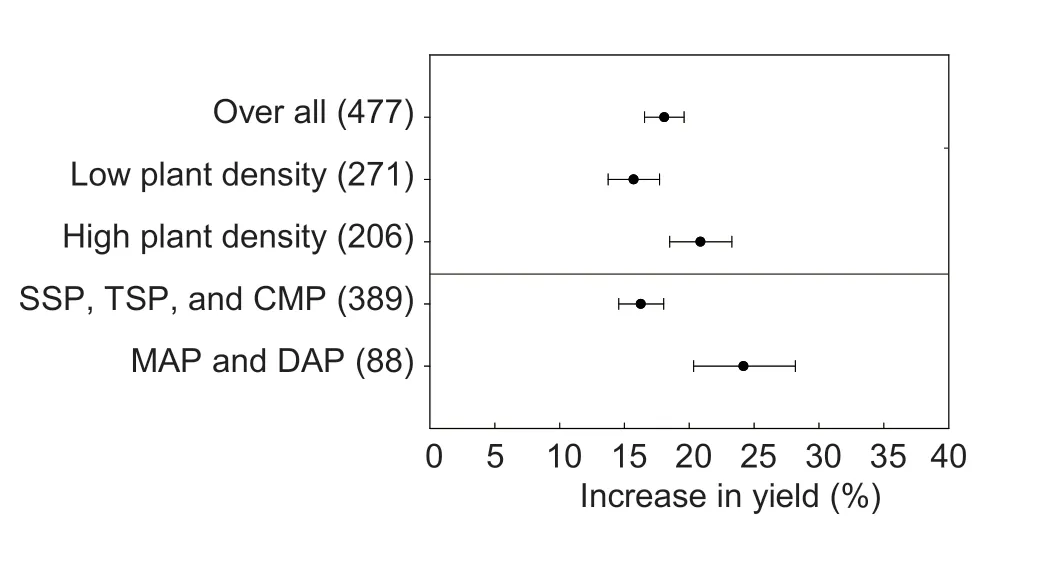
Fig.1 Increase in maize yield in response to mineral P fertilizer application,and plant density.SSP,super-phosphate;TSP,triple super-phosphate;CMP,calcium magnesium phosphate;MAP,monoammonium phosphate;DAP,diammonium phosphate.The numbers in parentheses indicate the number of observations.The data points represent the mean effect size,and the error bars represent 95% confidence intervals.
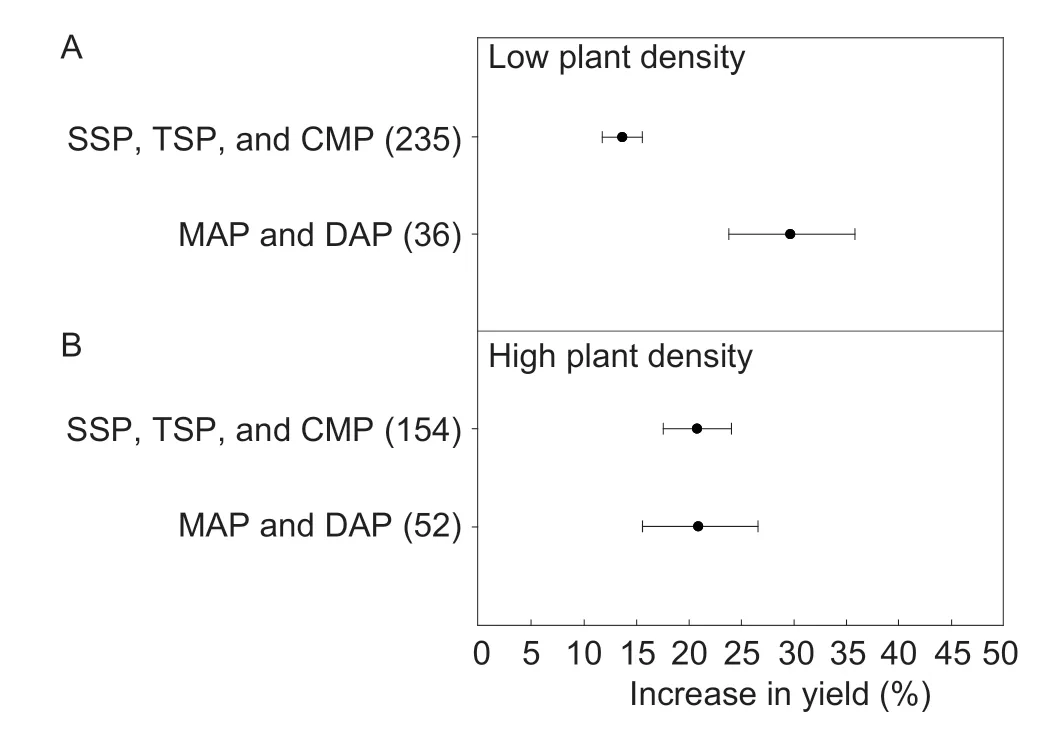
Fig.2 Increases in maize yield resulting from the application of various mineral P fertilizer types under (A) low and (B) high plant densities.SSP,super-phosphate;TSP,triple super-phosphate;CMP,calcium magnesium phosphate;MAP,monoammonium phosphate;DAP,diammonium phosphate.The numbers in parentheses indicate the number of observations.The data points represent the mean effect size,and the error bars represent the 95% confidence intervals.
To investigate the potentially important predictors of maize yield response to low-concentration P fertilizers at high plant density,we conducted random forest modeling that integrated environmental factors and field management practices,including pH,SAP,MAT,MAP,and P input.The model showed that SAP was the most critical variable affecting maize yield response to P,followed by pH,MAT,and MAP.Total P input had no significant effect on maize yield response to P.Structural equation modeling was performed to analyze the indirect effects of multiple variables on maize yield (Fig.3).MAT and MAP indirectly affected maize yield by exerting positive and negative effects on soil pH,respectively.The effect of total P inputs on soil pH led to positive changes in maize yield.

Fig.3 Climatic and edaphic variables and management practice that affect yield response to low-concentration P fertilizers at a high plant density.A,relative importance of variables on yield response to low P concentration fertilizers at high plant density.SAP,soil available P;MAT,mean annual temperature;MAP,mean annual precipitation.B,structure equation modelling analysis of the direct and indirect mediation of climatic and edaphic variables and management practice factors on yield response to low P concentration fertilizers at high plant density.The thickness of the arrow represents the strength of the relationship.Red and black lines represent significant negative and positive pathways,respectively.Grey lines represent non-significant pathways.Values on lines are standardized path coefficients,*,P<0.05;**,P<0.01.
3.2.P flow from RP mining to maize production at different plant densities
We investigated the flow of P from RP mining to use in maize production at different plant densities.At low plant densities,51.1 and 45.1 kg P ha-1from low-and highconcentration mineral P fertilizers were required to produce 8.2 and 9.3 t ha-1maize,respectively;and 63.8 and 57.6 kg P ha-1from RP was required,respectively.However,only 25.7 and 29.0 kg P ha-1of low and high P concentration fertilizers were used by maize,which indicated that 39.7 and 30.2 kg P ha-1were lost to the environment.Approximately 51.2 and 37.9% of P was lost during crop production under low-and high-concentration fertilizer use,respectively.At high plant densities,to produce 9.7 and 10.8 t ha-1grain with low-and high-concentration P fertilizers,40.5 and 50.9 kg P ha-1was needed,with 50.6 and 65.1 kg P ha-1from RP,respectively;however,only 30.4 and 33.9 kg P ha-1was used for maize production,leading to a loss of 21.8 and 32.8 kg P ha-1to the environment (Fig.4;Appendices D and E).Consequently,at high plant densities,approximately 22.4 and 27.9% of P were lost during maize production when low-and highconcentration P fertilizers were used,respectively.

Fig.4 P flow (kg P ha-1) from rock phosphate (RP) mining to maize production according to the meta-analysis of P-related studies.A,super-phosphate (SSP),triple super-phosphate (TSP),and calcium magnesium phosphate (CMP) at low plant density.B,diammonium phosphate (DAP) and monoammonium phosphate (MAP) at low plant density.C,SSP,TSP,and CMP at high plant density.D,DAP and MAP at high plant density.All the data's unit is kg P ha-1.
The type of mineral P fertilizer used influenced the P resource use efficiency and P-related footprint,which varied depending on the plant density.The P resource use efficiency of the high P concentration fertilizers was significantly (P<0.05) higher than that of the low P concentration fertilizers (Appendix F).In contrast,maize yields resulting from high P concentration fertilizers had a higher P-related environmental footprint than yields resulting from low P concentration fertilizers,regardless of plant density (Appendix F).The P resource use efficiency with SSP,TSP,or CMP application was significantly higher than that with DAP or MAP application.In contrast,at high plant densities,a 17% larger P-related environmental footprint was observed with high-concentration fertilizers than with low-concentration fertilizers (Fig.5).
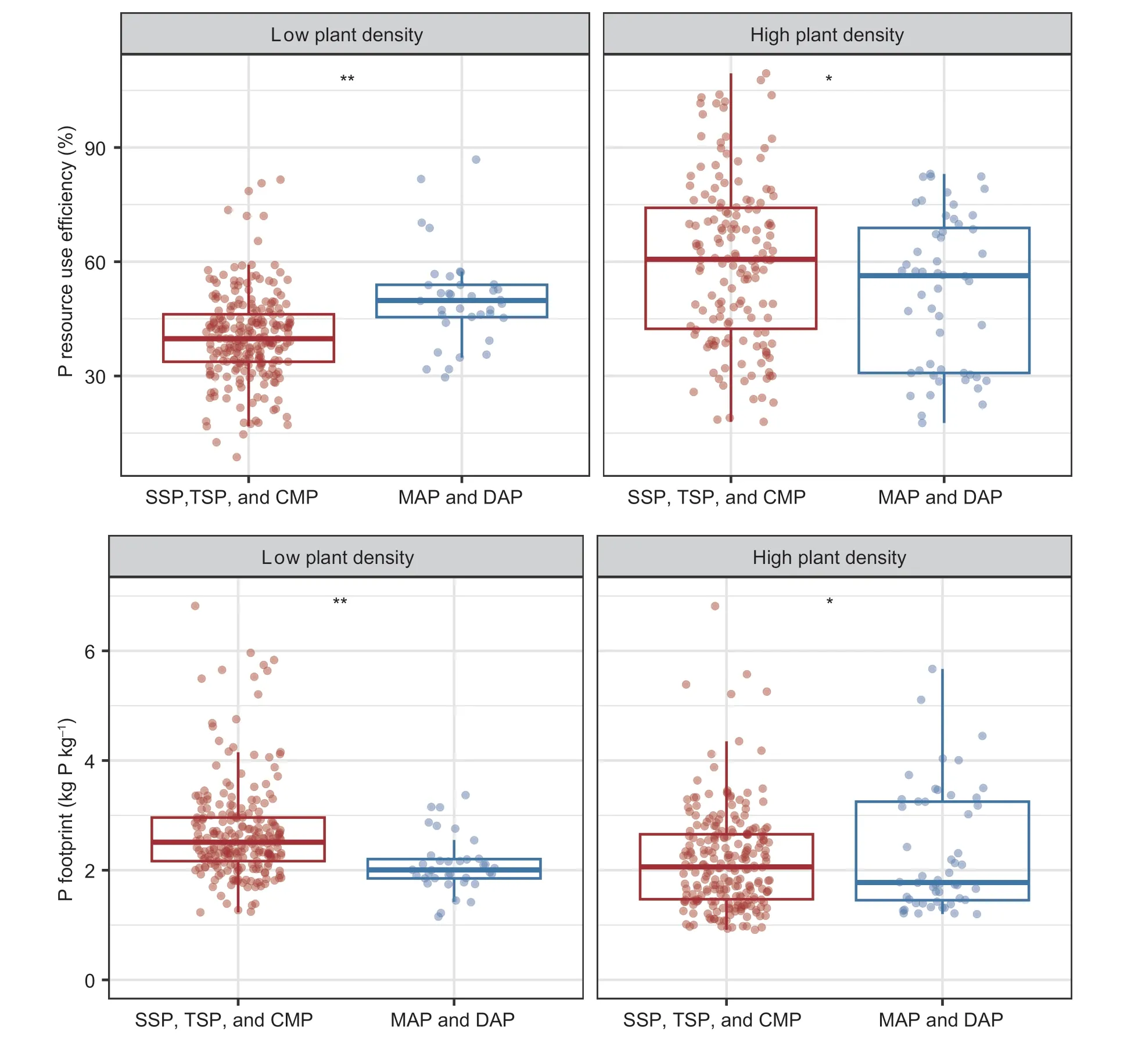
Fig.5 P resource use efficiency and P-related environmental footprint across the entire P supply chain when different mineral P fertilizers were applied to low and high plant densities of maize.Fertilizers include super-phosphate (SSP),triple super-phosphate (TSP),calcium magnesium phosphate (CMP),monoammonium phosphate (MAP),and diammonium phosphate (DAP).Asterisks indicate significant difference between fertilizer types,*,P<0.05,**,P<0.01.
3.3.lmproving maize yield and mitigating P-related environmental footprint size by integrating mineral P use and plant density
We aimed to optimize strategies to achieve high maize production while lowering the P-related environmental footprint.At high plant densities,a lower P-related environmental footprint,without yield losses,was obtained using low-concentration P fertilizers (SSP,TSP,and CMP).Furthermore,the increase in yield was higher at an application rate of 35-50 kg P ha-1,compared to other P fertilizer application rates (Appendix G).The optimized scenario involved the integration of lowconcentration P fertilizers at an application rate of 35-50 kg P ha-1with high plant densities.Our results indicated that maize yield improved significantly under optimized conditions compared to average conditions included in all studies (Fig.6-A).Specifically,the reported yields were 22% higher in the studies included in our meta analysis after integrating P management strategies,optimizing P inputs (amount and type of mineral P fertilizer),and planting at high plant density.P resource use efficiency throughout the supply chain under optimal conditions significantly (P<0.05) increased (by 39%) relative to that under average conditions (Fig.6-B).Improving the efficiency of P use in the supply chain directly reduced the amount of P lost between RP mining and P use in maize production,thereby reducing the P-related environmental footprint.The P-related footprint under the optimized conditions was mitigated by 33% (Fig.6-C) compared to that under the average conditions.
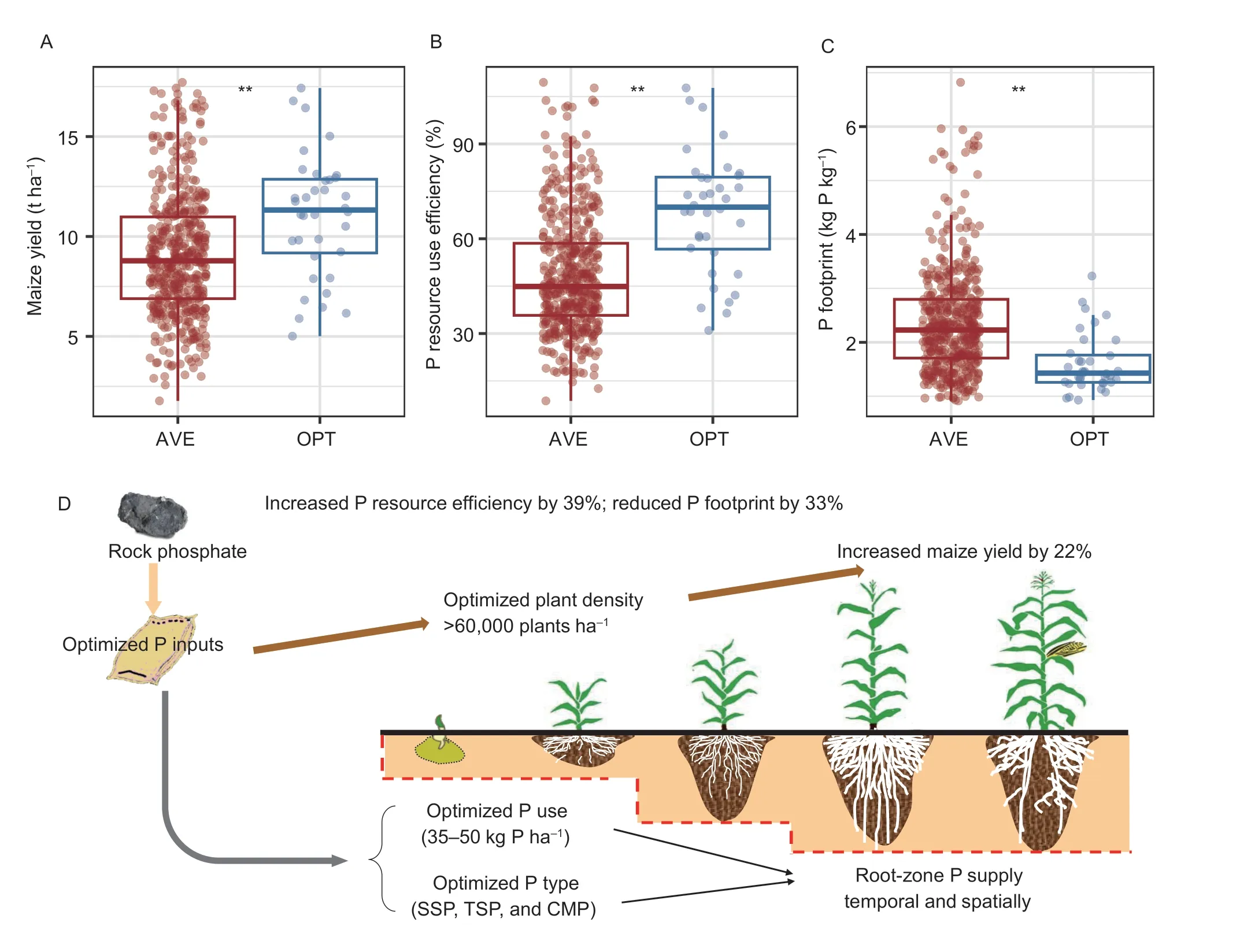
Fig.6 Differences in maize yield (A),P resource use efficiency (B),P-related footprint between optimized (OPT) and average (AVE) conditions (C),and conceptual diagram of integrated P management (appropriate P types and application),and cropping techniques (high planting densities) for the multi-objective optimization of maize production (D).AVE conditions represent the conditions covered by all studies used in the meta-analysis (n=477);OPT conditions include the application of SSP,TSP,or CMP fertilizers at 35-50 kg P ha-1 under high plant densities (n=36).SSP,super-phosphate;TSP,triple super-phosphate;CMP,calcium magnesium phosphate.Asterisks indicate significant difference between average and optimized conditions,*,P<0.05,**,P<0.01.
4.Discussion
4.1.Mitigation of the P-related environmental footprint while maintaining high maize yield using low P concentration fertilizers and high plant density
Increasing maize yield while reducing the P-related environmental footprint is one of the greatest challenges in sustainable agriculture (Caliciogluet al.2019).Implementing an integrated system-based strategy that considers P management and cropping techniques,rather than focusing on individual P management practices,could enhance maize productivity and reduce the P-related environmental footprint (Wanget al.2020).Our analyses indicated that multi-objective optimization could be achieved by combining certain mineral P fertilizer types and rates with high-density planting,and result in maize yields improving by up to 22% relative to average conditions.Under optimized conditions,the P resource use efficiency in the supply chain could be increased by 39%,and the P-related environmental footprint could be mitigated by 33% (Fig.6-A-C).Thus,the coordination between mineral P fertilizer management (appropriate P types and application rates) and cropping techniques (high planting densities) provides a potential route for achieving sustainable P use in maize production (Fig.6-B).This strategy can serve as a reference for developing countries with ecological conditions similar to those in China (Wanget al.2020).Adapting the optimized strategy to meet local requirements could help improve maize yields and P utilization while reducing the P-related environmental footprint.
One management practice for reducing the reliance on high-concentration P fertilizers is to employ an increased plant density because it leads to greater efficiency in extracting and using soil P and reducing the P-related environmental footprint.Thus,increasing planting density could effectively improve the yield in agricultural systems.This finding is consistent with the work of Assefaet al.(2016) and Luoet al.(2020),who reported that the response of maize yield to mineral P fertilizers is affected by plant density.In the present study,a larger increase in maize yield was observed at high plant densities than at low densities,possibly because of the improved light interception and photosynthetic rate under a higher planting density (Liuet al.2017;Xuet al.2017).High plant densities have the potential to initiate a virtuous cycle,in which P removal from the soil is increasedviauptake by crops,and the P-related environmental footprint under high-density conditions is decreased owing to the high above-ground biomass and increased P-uptake rates (Gonget al.2022).The lower P-related footprint at a high maize planting density means that less P fertilizer input is required,making the crop system more sustainable and less harmful to the environment.
The greater increase in maize yield observed at low plant densities with the use of MAP and DAP was related to the release of NH4+and PO43-,which promote lateral root branching and enhance P absorption (Limaet al.2010;Giehl and von Wiren 2014).Improved plant root development induced by MAP and DAP can provide more initially available P to plants compared with that following the application of SSP,TSP,or CMP (Chienet al.2011).However,low-concentration P fertilizers (SSP,TSP,and CMP) in the present study were also associated with increased maize yield at high planting densities,with results similar to those for MAP and DAP.This may be primarily attributable to a deficiency in P resulting from increased competition at high plant densities based on the increased crossing and overlapping of roots (Liet al.2019;Gaoet al.2021).It is generally accepted that a low soil SAP is associated with greater increases in remaize yield in response to mineral P fertilizer.Notably,the capacity for rapid P capture from the soil is high because maize plants are generally grown in humid temperate environments and have well-developed root systems (Zhouet al.2019).Under these conditions,low-concentration P fertilizers (SSP,TSP,and CMP) are sufficient to satisfy the P requirements of maize (Gonget al.2022).Our results showed that climatic factors (MAT and MAP) impact soil conditions and thus have an indirect positive or negative effect on the response of maize yield to low-concentration P fertilizers at high plant densities.Therefore,high maize productivity was also achieved by applying low-concentration P fertilizers at high plant densities.
4.2.lntegrating P management and cropping technologies leads to sustainable P use for maize production
From a systemic perspective,sustainable P use requires the optimization of external inputs while maximizing agricultural outputs (Witherset al.2015;Tianet al.2021).High maize production relies heavily on large inputs of mineral P fertilizers (Liet al.2016),which results in relatively low P use efficiency (Chen and Graedel 2016;Wanget al.2018).A wide variety of P-related environmental impacts are observed when high rates of mineral P fertilizer are applied to agricultural systems (Royet al.2014;Sharpley and Wang 2014).Ensuring grain crop production while avoiding the associated detrimental environmental effects is becoming increasingly important.To achieve this,the types and application rates of mineral P fertilizers must be optimized based on crop demand (Wanget al.2018;Jianget al.2019;Wuet al.2021).Furthermore,to increase maize production while reducing the agro-environmental footprint,it is essential to integrate P management techniques,such as optimizing P application rates and fertilizer types,with specific cropping techniques,such as high-density planting.Integrated P management techniques can simultaneously achieve a high maize yield and low P-related footprint.
The sustainable use of P depends on an interdisciplinary and systemic approach (Houet al.2020;Rabbaniet al.2022;Shokouhifaret al.2023) that integrates cropping techniques (such as increased plant density) and optimizes mineral P fertilizer management (such as appropriate P types and application rates) from primary resources to agricultural applications.Optimizing mineral P fertilizer management in a targeted manner can increase maize yield and mitigate the P-related environmental footprint throughout the supply chain.In addition,high planting densities can further increase the P-acquisition efficiency of plant roots and reduce mineral P-fertilizer requirements (Shenet al.2013).However,increasing maize yield while reducing the P-related environmental footprint in the supply chain requires a combination of these solutions.Integrating cropping techniques with optimized mineral P fertilizer management is a viable option that offers a basis for scientists,farmers,and policymakers to sustainably manage P resources.Additionally,this strategy can support efforts to mitigate the P-related environmental footprint throughout the P supply chains in China and other developing countries.
4.3.Uncertainties and limitations
We systematically assessed maize yield responses under different mineral P fertilizer application rates,different plant densities,and the corresponding P-related environmental footprint.Integrated P management improved the sustainability of maize systems by harmonizing mineral P fertilizer management and planting density.Our meta-analysis was conducted based on 388 peer-reviewed articles identified according to certain keywords and research topics;thus,some studies might have been missed.Furthermore,owing to data limitations,different spatial patterns across China where climate,soil,and fertility may be important determinants could not be considered.Although the data obtained from published field experiments were distributed across key maize-producing regions in China,investigator bias and differing methodologies may have resulted in inconsistent data quality.Thus,additional influencing factors,such as those mentioned above,should be comprehensively explored by considering additional field experiments in different regions nationwide to better understand the need to adapt P management strategies.
Although the P-related environmental footprint under different plant densities are quantified in this study,the acquired data were subject to uncertainties that limited the robustness of our results and conclusions.For example,the parameters used in our calculations,such as maize P content and P loss from RP mining to maize production,were average values obtained from the literature.However,these values may vary among crop varieties and planting regions.Minimizing these uncertainties may be possible by analyzing extensive reference data from published articles,questionnaires,and interviews.Therefore,we suggest that future studies include data from multi-regional experiments and ongoing field monitoring programs.
5.Conclusion
The application of low-and high-P concentration fertilizers did not result in significant differences in maize yield at high plant densities.However,combining optimal P application rates (30-50 kg P ha-1) and types (SSP,CMP,and TSP) with high plant densities (>60,000 plants ha-1) increased maize yields by 22%,improved P resource use efficiency by 39%,and reduced the P-related environmental footprint in the supply chain by 33%.These findings indicate that the trade-off between enhanced food production and mitigated P-related environmental footprint can be overcome by optimizing P management and cropping techniques.This is important for relieving environmental pressure,increasing P resource use efficiency,and maintaining stable maize production in China.The findings showed that both environmental and sustainable P use objectives were simultaneously addressed by integrating mineral P use and plant density,which represents an effective approach to improving the overall sustainability of the entire P supply chain from RP mining to maize production.Further research should focus on the mechanisms underlying the use of P by maizeviathe integration of mineral P use and plant density.
Acknowledgements
This work was supported by the National Natural Science Foundation of China (32301453 and 3272675),and the China Postdoctoral Science Foundation (2023M730682).
Declaration of competing interest
The authors declare that they have no conflict of interest.
Appendicesassociated with this paper are available on https://doi.org/10.1016/j.jia.2023.10.018
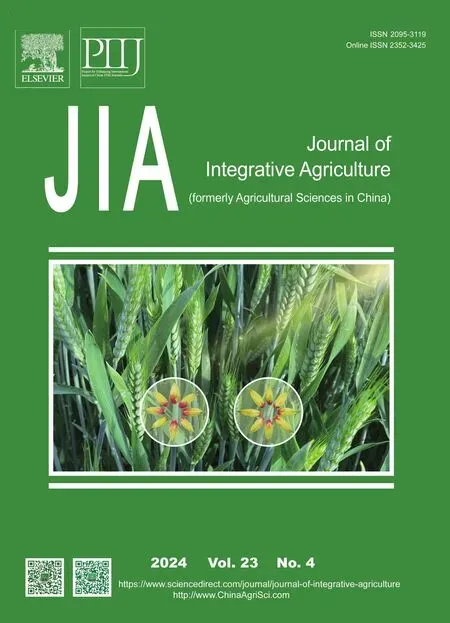 Journal of Integrative Agriculture2024年4期
Journal of Integrative Agriculture2024年4期
- Journal of Integrative Agriculture的其它文章
- Invasion of fall armyworm led to the succession of maize pests in Southwest China
- Genome-wide and candidate gene association studies identify BnPAP17 as conferring the utilization of organic phosphorus in oilseed rape
- Impacts of agri-food e-commerce on traditional wholesale industry: Evidence from China
- Transcriptomic and metabolomic analysis provides insights into lignin biosynthesis and accumulation and differences in lodging resistance in hybrid wheat
- Responses of growth performance,antioxidant function,small intestinal morphology and mRNA expression of jejunal tight junction protein to dietary iron in yellow-feathered broilers
- Genome-wide identification of the CONSTANS-LIKE (COL) family and mechanism of fruit senescence regulation by PpCOL8 in sand pear (Pyrus pyrifolia)
